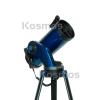CONTACT US FOR INFO AND PRICING
The ClimaVUE™50 is an affordable all-in-one meteorological sensor that fulfills your common weather monitoring needs with simplicity, when paired with any of Campbell Scientific's highly flexible and scalable data collection platforms. This sensor uses SDI-12 to report air temperature, relative humidity, vapor pressure, barometric pressure, wind (speed, gust, and direction), solar radiation, precipitation, and lightning strike (count and distance). It does this with no moving parts, while consuming little power. A built-in tilt sensor assures long-term data integrity. This diverse product is great for quick deployment, for remote locations, for large networks, as part of a more complex system, or if you just need something simple.
Benefits and Features
- All the common meteorological measurements with one simple digital (SDI-12) output
- Less than 1 mA at 12 Vdc average current, making it ideal for solar-powered sites
- Integrated tilt sensor helps assure that the sensor stays level over time
- Low maintenance—no moving parts significantly reduces maintenance cost and time
- No sensor configuration required
- Compact design for quick, low-impact installation
- Compatible with all modern Campbell Scientific data loggers
- Detachable cable facilitates field replacement
Sensors
All sensors are integrated into a single, small form-factor unit, requiring minimal installation effort. With a robust, no-moving-parts design that prevents errors because of wear or fouling, the ClimaVUE™50 is ideal for long-term, remote installations.
Pyranometer
Solar radiation is measured by a pyranometer that is integrated into the lip of the rain gage funnel at the top of the ClimaVUE™50. The miniature pyranometer uses a silicon-cell sensor to measure the total incoming (direct and diffuse) solar radiation. Silicon-cell sensors have excellent response time to changing radiation conditions and acceptable sensitivity across the solar spectrum, which make them well-suited for use on the ClimaVUE™50.
A carefully developed cosine-correcting head ensures accurate readings regardless of sun angle, while the painstakingly researched optical filter material balances cost and performance to ensure the silicon-cell provides the ClimaVUE™50 with good accuracy regardless of temperature or sensor age.
Anemometer
The space underneath the rain gage is where the ClimaVUE™50 measures wind speed. Ultrasonic signals emitted from transducers at right angles to each other bounce off the porous sintered glass plate and back up to the opposite sensor. The speed of sound is affected by the wind, and the wind speed is calculated by measuring differences in the time it takes for sound to travel from the transmitters to the receivers.
Temperature Sensor
The ClimaVUE™50 temperature measurement is made in the center of the anemometer area where a small stainless-steel needle containing a tiny temperature sensor (thermistor) extends from the middle of the four sonic transducers in the center of the anemometer.
Unlike most air temperature measurements, the temperature sensor is not covered with louvered plates to protect it from solar heating. Instead, it sits in open air, susceptible to solar heating of the instrument body. However, the ClimaVUE™50 accurately corrects the measured air temperature because solar radiation and the wind speed are known. These two are the main variables that determine the error between measured air temperature and the actual air temperature. An energy balance equation is then used to calculate what the actual temperature should be to an accuracy of ±0.6°C.
Relative Humidity Sensor
The relative humidity sensor on the ClimaVUE™50 is located behind the circular Teflon™ screen close to the sonic transducers. The Teflon screen protects the sensor from liquid water and dust while allowing water vapor to freely pass to the sensor. The ClimaVUE™50 measures relative humidity and temperature and computes vapor pressure.
Drip Counter Rain Gage
The ClimaVUE™50 contains a 9.31 cm (3.67 in.) diameter rain-collection funnel. A spring in the funnel acts as a filter to keep out large particles while allowing enough flow so water does not back up. Rain collected by the funnel exits the funnel through a precision flared hole that forms the rain into drops of a known size. The falling drops hit and momentarily bridge the gap between two gold pins, creating an electrical pulse.
The ClimaVUE™50 counts the pulses (drops) and calculates the water volume. As the rain intensity increases, the drops become smaller, but the ClimaVUE™50 firmware contains an algorithm to automatically compensate for drop size as the rain increases.
Note: This non-heated sensor is not suitable for solid precipitation measurements or riming environments.
Tilt Sensor
The ClimaVUE™50 is also equipped with a tilt sensor. The primary use of the tilt sensor data is to ensure the ClimaVUE™50 remains level at all times. Regularly check X and Y tilt data to ensure the ClimaVUE™50 is level; if it has tilted, return to the site and level again. Three degrees off level can cause errors in the rain and solar radiation measurements. Although this sensor's readings may be used to level the instrument during installation, it is much easier to use the small bubble level on the bottom of the anemometer plate.
Mounting
The ClimaVUE™50 includes a V-bolt for mounting to a pipe with a nominal outer diameter of 31.8 to 50.8 mm (1.25 to 2.0 in.). This allows the sensor to mount directly to a tripod mast or CM300-series mounting pole, or to a crossarm using the 17387 mounting pipe kit.

